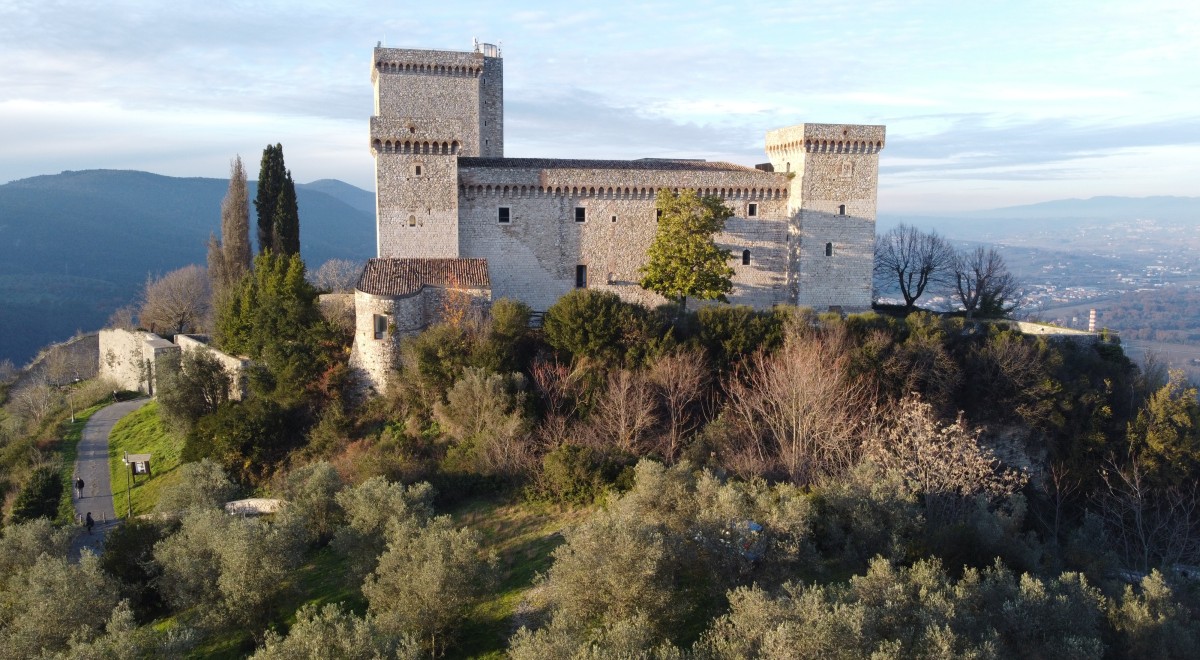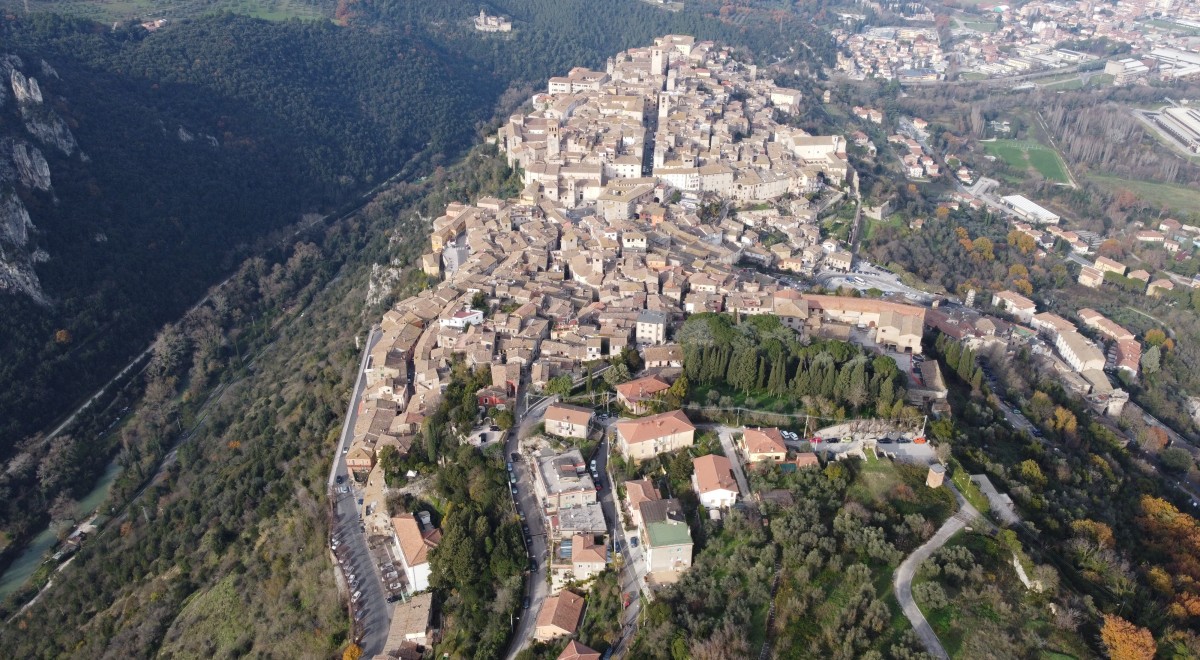
The Middle Ages in Narni
Narnia in the early Middle Ages
The fall of the Roman Empire and the barbarian invasions hit the territory of Narnia, which like the other cities along the Via Flaminia was incorporated into what later became the Byzantine Corridor.
During the Greco-Gothic War, Bessa, in the company of the Byzantine general Belisarius, stopped in 536 for some time near the city that allowed him to defeat the vanguards of the Goths of Vitige. In 545 it was Totila who devastated Narnia, although the hagiography of San Cassio gives an account of a miracle of the Saint, thanks to which the destruction of the city would have been avoided.
It is probably of this period the construction of the first structure that then became the fortified Abbey of San Cassiano on mount Santa Croce in front of the city, as is likely to be found in the former Church of San Domenico, now Auditorium Bortolotti, the area where the place of worship stood since the fourth century and the bishop's seat. The mosaic found recently along the left aisle is certainly Byzantine.
The strategic role of Narnia was then confirmed in the following period, when with the arrival of the Longobardi and the establishment of the Duchy of Spoleto, the city had to submit to the expansionist aims of duke Ariulfo between the years 591 and 592. Alternatively lost and reconquered by the dukes of Spoleto and belonged for a short time to the property of Countess Matilde di Canossa, in 741 the city was assigned by the Franks to the Church State.
Between the IX and the X century the first nucleus of the church of Santa Maria Impensole was built, whose patron was probably Pope Giovanni XIII, former bishop of Narni.
In the central centuries of the Middle Ages it experienced that growth that led it to be a point of reference among the municipalities of the center of the peninsula, so much so as to be known as a "superb" city.
Narnia in the late Middle Ages
Starting from the 11th century, the medieval city, after rebelling in 1112 against Pope Pasquale II, in 1167 against Federico Barbarossa and after siding in 1242 with Rome and Perugia against the Empire, projected its territorial influence on San Gemini, Stroncone, Calvi and Otricoli.
It is in this period that the first tower houses were built that materially characterized the status of some noble families and it is in this period that the Church of San Giovenale was built, that would become the Cathedral of Narni only the following century at the hands of Pope Eugenio III.
In 1143 it was a free commune and a period of radical transformations began:
the Platea Major - today Piazza dei Priori - replaced the area of the Roman forum;
They built the great civil and religious buildings such as the Palazzo del Podestà, the Palazzo dei Priori, the Churches of San Domenico and Sant'Agostino, decorated with works by nationally renowned artists.
In 1373 it was held by the Orsini family, to whom it returned in 1409. In the fifteenth century it was occupied by Ladislao, king of Sicily, to be then absorbed by the Papal States thanks to the intervention of Braccio da Montone.
From this period onwards, Narni became part of the territories controlled by the papacy, thus losing its independence. Under the pontificate of Gregorio XI was erected by Cardinal Albornoz, on older pre-existing, the imposing fortress that still dominates the city from above.
Narnia in the Statutes of 1371 and the Corsa all'Anello.
The event that is celebrated between late April and early May, dedicated to the celebrations in honor of the Festa di San Giovenale, is the representation of Narni told by the Statutes of 1371.
No event in Narni exceeded for pomp and duration what was held in honor of the Holy Giovenale, the first bishop of the city whose feast is celebrated on May 3.
It was the citizens' statutes in 1371 to codify what were the ancient rites and ludi that were held in Narni in honor of the patron:
• On 1 May the auctioneer made public the event;
• On the evening of 2 May, after the sun had set, there was an impressive procession, under the banner-waving, accompanied by religious choirs and the sound of musical instruments, in the Cathedral where the Castles and the Guilds of the Arts were invited to make their own offering of wax (luminary).
• On May 3, the day dedicated to San Giovenale, after a solemn religious ceremony in the Cathedral, the festival took on its own playful character, leaving room for the traditional equestrian games: the Corsa del Palio and the Corsa all'Anello. The latter was reserved for knights narnesi who owned a horse; the Dominus Vicarius invited all those who wanted to run, to line up at the corner of the church of San Salvato in Piazza dei Priori, then lash out with his rod or bordone to stick the target worth 100 money Cortonesi. The order of departure was established by the statutary norms according to the membership of the Military Brigades of the Terzieri in which the city was divided: Mezule, Fraporta and Santa Maria.
In addition to bringing the colours and scents of the new season, spring in Narni means Corsa all'Anello. This event offers a full program of cultural, spiritual and food and wine initiatives, which in two and a half weeks accompany the most felt moment: the Corsa all'Anello, which sees the three historic Terzieri on the second Sunday of May.
Sunday, May 4, 1969 was the day of the first edition of the "modern" Ring Race: from then on, the event has been enriched with activities and initiatives of great participation and care.
The calendar of events is very rich, usually starting from the penultimate week of April and ending on the second Sunday of May, when the initiatives take place day by day involving the many local associations with the national ones.
Among the events not to be missed:
• the Reading of the Bando and the passage of the auctioneer is the first initiative that, for centuries, opens the days of the race;
• the Medieval Days of the Terzieri;
• Medieval environments that revive some of the most characteristic places of the city;
• On the evening of May 2, the evocative Offering of candles for the Patron by the castles subject to Narni, parishes and guilds of arts and crafts, a ceremony that took place already in 1227.
• on 3 May the celebrations for the Feast of San Giovenale and the subsequent Historical Corsa all'Anello in Piazza dei Priori;
• in succession, one by evening, the traditional and evocative Benediction of the Knights of the three Terzieri and the subsequent procession to the Cathedral;
• the evening of Saturday before the Palio, the Great Historical Parade that sees parade over 800 participants;
• and the unmissable Corsa all'Anello at the Campo de li Giochi, preceded by the parade and shows.

The Middle Ages in Italy
The Middle Ages is usually divided into two periods: High and Low Middle Ages. After the year 1000 the Late Middle Ages began, during which there was a strong population increase thanks to technological and agricultural innovations and the flourishing of trade. The Middle Ages is a very long period, full of fascination for contemporary man; it is the era of Dante, Giotto, San Francesco, Federico II, Marco Polo, powerful Popes and great mystics venerated by the people. Medieval literature has handed down to us the deeds of valiant characters, the epic of chivalry, the troubadours, the Crusades and the long pilgrimages, the guilds of crafts and the birth of universities. Wonderful works of art have come down to us, such as the imposing Romanesque and Gothic cathedrals, castles and public buildings.
In the flourishing of the cities, in which the population was grouped, the phenomenon of free municipalities was born, which involved much of Europe and in particular central and northern Italy. The municipalities were the highest expression, at the political, juridical and administrative level, of the autonomy gained by medieval men against the traditional higher authorities such as the papacy and the great nobility.


